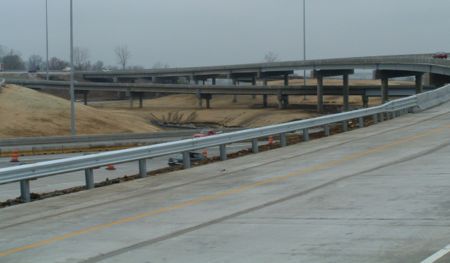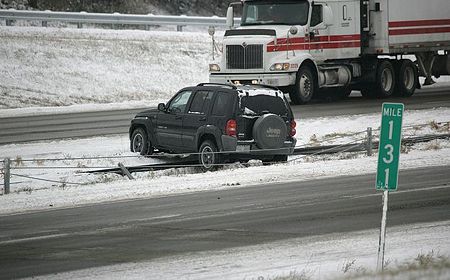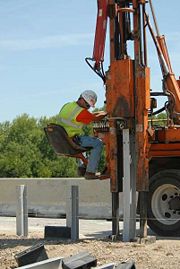Category:606 Guardrail and Guard Cable: Difference between revisions
m updated link |
m minor correction |
||
| Line 67: | Line 67: | ||
The table entitled "What is TL-3?" summarizes data for the six test levels. | The table entitled "What is TL-3?" summarizes data for the six test levels. | ||
A roadside safety hardware feature must undergo rigorous safety | A roadside safety hardware feature must undergo rigorous safety testing before it can be used on the National Highway System (NHS). Most states have adopted the same testing criteria for highways that are not on the NHS. The standard by which all roadside safety features are measured is contained within the NCHRP 350. | ||
NCHRP 350 evaluates safety hardware according to three general factors: | NCHRP 350 evaluates safety hardware according to three general factors: | ||
Revision as of 15:26, 10 July 2012

| Additional Information |
| Guard cable info |
| Guard Cable Video |
| Guard Cable in Action |
About one in every three fatal accidents is a result of a single vehicle leaving the road. For this reason, roadside safety must be given the same level of scrutiny as the travelway. National best practice indicates the concept of the forgiving roadside as the responsible approach.
Shielding. In many cases, it is either impractical or impossible to remove the obstacle, redesign the obstacle so it can be safely traversed, relocate the obstacle to a point where it is less likely to be struck or reduce impact severity by using an appropriate breakaway device in order to produce a forgiving roadside. In these cases, shielding will likely be used to protect the errant vehicle from the obstacle.

Shielding is simply the use of a barrier to physically separate the vehicle from the obstacle.
Barriers, whether they be concrete, guardrail or guard cable are themselves roadside obstacles. Even though they are engineered and rigorously tested to preserve the safety of vehicle occupants, all shielding systems cause damage to the vehicle and/or sustain damage themselves when struck. This is why their use is preferable only to obstacle delineation, which is widely considered a last resort.
Guardrail. Guardrail consists of heavy-gauge rolled steel beams mounted on strong posts. It is used to protect traffic from roadside obstacles or to prohibit traffic movements. Guardrail is used when the severity of an accident involving an obstacle would be greater than the severity of an accident involving the rail itself.
Guard Cable. Guard cable contains and redirects vehicles from impacting a fixed object or terrain that is less forgiving than the guard cable. It consists of steel cables mounted on weak posts and is relatively inexpensive to install and very effectively captures errant vehicles.
Except for when it is used in medians, guard cable (instead of guardrail) on new construction projects is to be limited to locations outside the clear zone, but where the designer wants to protect an errant vehicle from driving over a steep, high fill area. Substitution of guard cable for guardrail is not recommended on sharp curves or on facilities with high truck traffic. Guard cable is also commonly used in freeway medians.
Testing Criteria. Within the National Cooperative Highway Research Program Report No. 350 (NCHRP 350) are six separate test levels (TL) representing different vehicles, impact angles and speeds.
| Test Level | Vehicle | Angle (degrees) | Speed |
|---|---|---|---|
| 1 | 1800 lb. car | 20 | 30 mph |
| 4400 lb. pickup | 25 | 30 mph | |
| 2 | 1800 lb. car | 20 | 45 mph |
| 4400 lb. pickup | 25 | 45 mph | |
| 3 | 1800 lb. car | 20 | 60 mph |
| 4400 lb. pickup | 25 | 60 mph | |
| 4 | 1800 lb. car | 20 | 60 mph |
| 4400 lb. pickup | 25 | 60 mph | |
| 17,600 lb. Single-Unit Truck | 15 | 50 mph | |
| 5 | 1800 lb. car | 20 | 60 mph |
| 4400 lb. pickup | 25 | 60 mph | |
| 80,000 Semi Truck (Cargo) | 15 | 50 mph | |
| 6 | 1800 lb. car | 20 | 60 mph |
| 4400 lb. pickup | 25 | 60 mph | |
| 80,000 lb. Semi Truck (Tanker) | 15 | 50 mph |
Test level three (TL-3) is probably the most common as it establishes safety criteria for both small cars and pickups at 60 mph. This category of traffic accounts for nearly 90% of all vehicle traffic in Missouri.
The table entitled "What is TL-3?" summarizes data for the six test levels.
A roadside safety hardware feature must undergo rigorous safety testing before it can be used on the National Highway System (NHS). Most states have adopted the same testing criteria for highways that are not on the NHS. The standard by which all roadside safety features are measured is contained within the NCHRP 350.
NCHRP 350 evaluates safety hardware according to three general factors:
- 1) Structural Adequacy: the system must contain and redirect the vehicle with no under-riding, overriding or penetration.
- 2) Occupant Risk: fragments of the system cannot penetrate the passenger compartment, the vehicle must remain upright during and after the collision, and the passenger must not undergo excessive impact or deceleration.
- 3) Vehicle Trajectory: after the impact, the vehicle should not intrude into adjacent traffic lanes nor should it exit the system at an angle greater than 60% of the entry angle.

Construction Inspection Guidelines for Sec 606
Construction Requirements (for Sec 606.3) Inspection of guardrail, crashworthy end terminals, three-strand guard cable and one-strand access restraint cable is usually done on a spot basis. The contractor is to be given enough reference points from which to establish line and grade. Points to check during installation are alignment of posts and possible damage from driving. Completed rail or cable should be checked for alignment, position with respect to the travelway, elevation and proper direction of lap for beams. Bolts are to be tight. All elements of construction are to be checked for damage.
Post driving frequently causes damage to stabilized shoulders. No installation is to be accepted until such damage has been satisfactorily repaired in a manner preventing ponding of water around the posts.
Delineators (for Sec 606.10.2.3). Delineators should be placed on all guardrail located 2 ft. or less from the edge of the shoulder. The delineators are to be spaced at 50 ft. intervals. Refer to this specification for more detail on delineator body, retroreflective sheeting and delineator color requirements.
Refer to EPG 1040 Guardrail, End Terminals, One-Strand Access Restraint Cable and Three-Strand Guard Cable Material for procedures establishing inspecting sampling, accepting and reporting of guardrail and guard cable material specified in Sec 1040.
Crashworthy end terminals (CET) may not be substituted for a lower type CET without the districts’s core team approval. For example, a Type D CET cannot be replaced by a Type C device.
Articles in "606 Guardrail and Guard Cable"
The following 3 pages are in this category, out of 3 total.